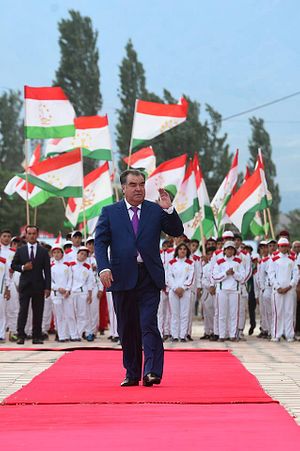On June 28, 1997 the New York Times ran a few sentences from the Associated Press on page two about the formal end of the Tajik Civil War:
Tajikistan’s president and a rebel leader signed a pact in Moscow formally ending the five years of civil war that ravaged the newly independent country. President Boris N. Yeltsin presided over the signing by President Emomali Rakhmonov and the rebel leader, Said Abdullo Nuri, at a Kremlin ceremony.
Twenty years later, both Yeltsin and Nuri are dead and Rahmon (having dropped the -ov from his name) stands alone claiming the title “The Founder of Peace and National Unity — Leader of the Nation.”
The peace agreement that ended the war is also dead. Core features — such as the incorporation of opposition representatives into the government, meeting a 30 percent quota and drawback of media restrictions — either never were implemented in full or have been eroded over time. The United Tajik Opposition is no more, and its major component, the Islamic Renaissance Party (IRPT), has been hounded from government after nearly 20 years of trying to participate in the system. The supposed guarantors of the peace accord — regional states like Uzbekistan and Kazakhstan, as well as the United Nations, Organization of Islamic Cooperation (OIC), and Organization for Security and Cooperation in Europe (OSCE) — have sat relatively idle as Rahmon consolidated his position.
There’s no doubting that the war was horrible. Bruce Pannier noted as much recently, writing about atrocities committed on both sides. (Also check out the Majlis podcast on this topic). Estimates vary wildly, but somewhere between 25,000 and 100,000 people died over the course of the five-year civil war.
In January 1997, a foreign correspondent by the name of Steve LeVine filed a story from Tursunzade, Tajikistan. The article, titled “Tajiks Talk of Peace Between Battles” explains some of the chaos present as the country lurched toward a peace settlement. While Rahmon now claims the mantle of a peacemaking unifier, LeVine outlined a more dismissive view back in 1997:
One problem is that Mr. Rakhmanov does not command much respect among the faction leaders he must impress. The former director of a collective farm, Mr. Rakhmanov rose to power in 1992 when Tajikistan’s strongest faction leader — who has since died in a shootout — anointed him as someone who should be president. Mr. Rakhmonov has hung on to power with the support of those who count — Russia and Tajikistan’s other conciliatory faction chiefs, who prop him up and are unlikely to accept any settlement with the rebels short of capitulation.
With such a weak president, the nation is flush not only with rebel commanders who do as they please, but also with ostensible government officers who ignore the central government, which lacks the power to discipline the wayward.
Rahmon has cleverly crafted strength from weakness, outfoxing his opponents, clinging to power and rewriting his own place in history. The 9/11 attacks, al-Qaeda’s holing up in Afghanistan, and the ensuing Global War on Terror provided an opportunity for Rahmon to reorient how the outside world (and the Tajik public, too) thought about the civil war. What was a complex and messy mix of post-Soviet politics, post-communist religious revival, and a scramble for power with ethnic and communal facets has since been simplified.
In the June issue of The Diplomat Magazine, Christian Bleuer reviewed the civil war and its legacy in present-day Tajikistan, noting how the government frames the civil war issue in modern discourse:
Whenever anybody advocates mobilizing for democratic change or the guarantee of human rights in Tajikistan, the Tajik government answers in the same way, arguing that reckless actions like protests, meetings, or the formation of new social movements or political parties would only create dangerous divisions and could even throw Tajikistan into a civil conflict just like Syria, for example (the country that serves as a warning changes occasionally, depending on what warzone is most prominent in the news).
Celebrating the anniversary of the peace accord in Vahdat on June 27, Rahmon never quite mentioned who the peace was settled with. He stressed the need for unity without acknowledging the causes of division.
Tajik journalist Bakhtiyor Sobiri wrote recently in an article for Open Democracy, that visitors to Dushanbe’s new Chinese-built Tajik national museum “may find it strange that the exhibition on ‘modern and contemporary history of Tajikistan’ makes no mention of the civil war. At Rahmon’s decree, these bloody years have no place in the national museum. The only acceptable way to speak about the war publicly is when attacking the opposition.”
Twenty years after the war ended, many of the major players are in their graves or behind bars. But as Bleuer, and many other regional scholars, have pointed out, the war may be over, the peace mostly in place, but the future of Tajikistan remains bleak.
LeVine’s January 1997 article included this evergreen sentence, which is as good a place to leave this discussion as any other:
So much has gone awry that most diplomats and local scholars produce little more than puzzled expressions when asked who is to blame.

































